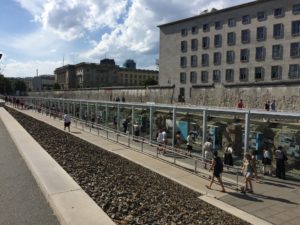
We spent the morning on a bus tour of Berlin.
Berlin is not a particularly old city by European standards, but it is even younger in appearance because it was essentially rebuilt after World War II.
At the same time, Berlin is very old for its age. It has enough history in the last one-hundred years to serve any other city for a millennium.
Between 9:00 a.m and 12:30 a.m. we drove through central Berlin, making stops at a remaining section of the Berlin Wall, the Brandenburg Gate, and the Kaiser Wilhelm Memorial Church.
After lunch, we all went our separate ways. The Wife went shopping, Ann went to see the Luther Exhibit at the Museum of History at Martin-Gropius-Bau, and Terri went to the Topography of Terror.
Trying to include as much as possible into our last day in Berlin, I walked to Checkpoint Charlie, the Topography of Terror, and then the Luther Exhibit at the Museum of History.
Of all that I saw, what I couldn’t stop thinking about was the section of the Topography of Terror that addressed the Lutheran Church’s support of Hitler and the Nazis. It was not anything I did not already know, but I think what was most visually shocking were two pictures there.
The pictures were of leaders of the German Evangelical Church at their National Synod on September 27, 1933 together with Nazi’s where they adopted the Aryan Paragraph and took the steps that would ultimately bring the church under the Nazi government, and it took place at Wittenberg. Right there, in the Old Town Square in front of the statue of Luther, with the spires of the Town Church where Luther preached in the background, where we had been just two days before, the German Church turned from following Jesus to follow a madman.
Equally shocking was how Hitler and the Nazis misappropriated and misrepresented Luther to seduce a German Church that had neither the discernment nor the courage to avoid spiritual adultery.
Some did though, chief among them, Dietrich Bonhoeffer. He is featured in the exhibit at the Topography of Terror. Bonhoeffer opposed Hitler and the Nazi’s, and the Aryan Paragraph. He stood in the tradition of Wycliffe, Hus, and Luther, and he did so at the cost of his life. Bonhoeffer would probably say it was the cost of grace, costly grace not cheap grace.
Another interesting visual at the Topography of Terror is found outside in front of the museum. On the ruins of the headquarters of the Gestapo and SS is a section of the Berlin Wall, both preserved as memorials, one on top of the other, curse upon curse.
Throughout Berlin one is constantly reminded of the horrors of the Nazis, the Holocaust, and the world war Germany initiated. One is also reminded of the evils of Communism. There is no attempt to justify, minimize, or cover-up. Instead these horrors are commemorated so the same “mistakes” are not made in the future.
Much of it feels more like penance than repentance though. True repentance is a turning from sin and a turning to God through faith in Jesus. Instead, what I saw in Berlin had the appearance of a worldly sorrow. See 2 Corinthians 7:10.
And so we have come full circle. Five hundred years ago, Martin Luther realized in reading Matthew 4:17 (“Repent for the kingdom of God is at hand”) in the Greek that the Latin Vulgate had misinterpreted the word “repent” as “do penance,” leading the Roman Catholic Church into gross theological error.
Just as the Roman Catholic Church had misinterpreted the words of Jesus, the post-war Germans have misinterpreted history. Germany’s Fascist and Communist horrors should not be interpreted as a call to penance but repentance.
And only repentance—a turning from sin and a return to King Jesus—will truly transform Europe. GS

